BMM Gep.MTW Vollkettenaufklürer 38 (t) Kätzchen armored personnel carrier (Germany)
It was now proposed to increase the mobility and combat capability of infantry with the help of new tracked vehicles with protection against small arms. weapons and small-caliber artillery, machine-gun armament and high mobility. The last parameter was planned to increase due to the rejection of the combined chassis using wheels and tracks. Auto Union and Böhmisch-Mährische Maschinenfabrik AG (BMM) were involved in the development of advanced armored vehicles. They had to create their own versions of the new armored personnel carrier, and then, at the beginning of 1944, to present models of such vehicles.
Both projects received the same official names Gepanzerter Mannschaftransportwagen or Gep.MTW, as well as VK 501. The first reflected the purpose of the vehicle (literally “Armored vehicle for transporting people”), and the second indicated the required fighting mass and noted that the equipment of a similar weight category had not been developed before. In addition, over time, both projects received the nickname Kätzchen ("Kitten"). It should be noted that the project of BMM company had another name - Vollkettenaufklürer 38 (t). This designation also described the purpose of the machine, but it also indicated the type of base chassis involved in the project.
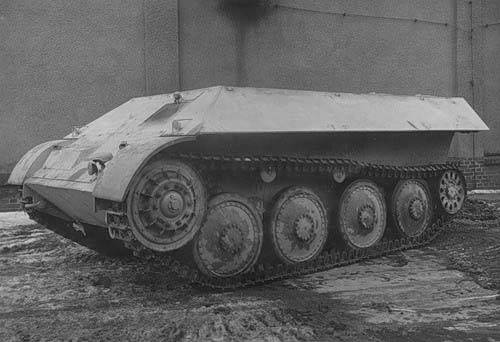
Prototype BTR BMM Kätzchen
To speed up the development and simplify the serial construction of new equipment, BMM designers decided to take one of the existing chassis as the basis for the armored personnel carrier. The basis for the project Vollkettenaufklürer 38 (t) was to be one of the latest modifications of the lung tank Pz.Kpfw. 38 (t). This armored vehicle has already become the basis for a number of models of armored vehicles for various purposes, and this list was to be replenished in the very near future. In addition, the characteristic appearance of the armored personnel carrier suggests that one of the "ancestors" of the Kätzchen was the self-propelled gun Jagdpanzer 38 Hetzer, also built on the basis of the Pz.Kpfw.38 (t) tank.
Interestingly, the two projects "Kitten" were developed by contracting firms themselves, but despite this, they used similar ideas and solutions. For example, in two projects a similar approach to the layout of the internal volumes of the hull was implemented. So, in front of the car should be placed transmission units associated with driving wheels. The other volume of the hull was mainly given under the total habitable volume in which the crew jobs and the troop compartment were located. The engine was proposed to be placed in the stern, inside a special casing placed at the starboard side.
The armored vehicle was supposed to receive an inclined upper frontal part of the hull, the thickness of which, according to some data, reached 50 mm. This sheet was placed at a large angle to the vertical. In the left part of the sheet there was a driver's access hatch, other openings were not provided. The hull sides were formed by lower vertical, middle horizontal and upper inclined sheets up to 30 mm thick. The upper part of the boards was a small fidget niche available to install the necessary units. The hull received a stern tilted back, made of a 20-mm sheet. Aft also had a protruding armor jacket of the engine cooling system with air louvers.
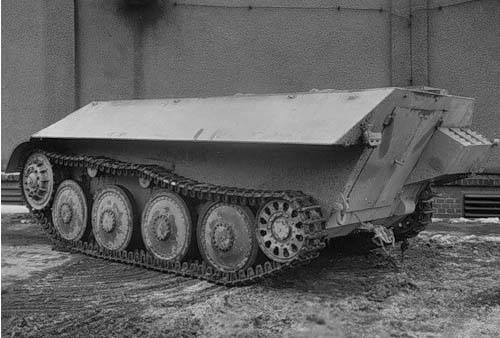
Prototype, aft view
At the design stage, BMM engineers could not decide on the type of engine. In the aft hull housing could fit two options for the power plant. The basis of the first was the Tatra 103 carburetor engine with 220 horsepower, the second used the Praga NR engine with horsepower 280. Regardless of the type of engine, a cardan shaft connecting the engine with the front transmission had to pass along the right side of the hull. Unlike the competitor, the BMM Kätzchen armored personnel carrier had to be equipped with a mechanical transmission, which was mastered in production and tested in practice.
The undercarriage of the Vollkettenaufklürer 38 (t) was typical of armored vehicles created by BMM. On each side of the hull it was proposed to mount four large-diameter skating rinks with rubber bands. The rollers were blocked in pairs and received a suspension based on leaf springs: the ends of the elastic element rested against the bushings of the rollers, and the center was fixed near the axes of their balancers. Front drive and stern guide wheels have been retained. Like the later versions of the vehicle based on the Pz.Kpfw.38 (t), the armored personnel carrier received two pairs of support rollers placed above the two front spaces between the support rollers.
The crew of the armored vehicles should have included two people: a driver and commander. Their jobs were placed in the front of the habitable compartment. The driver was placed directly in the front of the hull, on the left side and could follow the road with a flap with a cover in the front plate. The commander was located to his left and with a noticeable backward shift, and also did not have his own viewing instruments. In carrying out the tasks of the shooter, the commander could observe over the hull sides. This placement of the commander’s seat was due to the layout of the transmission. Most of its units were located at the starboard side and did not leave room for the installation of additional jobs.
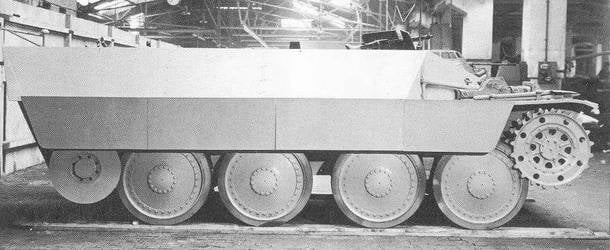
Layout in the assembly shop
Requirements for the project "Kitten" implied the use of machine-gun weapons for self-defense and support of the landing force. For reasons of optimizing the layout, it was decided to abandon the machine-gun in the front sheet, the type used in the project of the company Auto Union. The MG 34 or MG 42 machine gun was supposed to fit on a system borrowed from existing armored personnel carriers. The machine-gun unit with an armor shield was located on a special stand on the axis of the car behind the driver’s workplace.
There is also information about attempts to equip an Boll Vollkettenaufklürer 38 (t) with second attachments for a machine gun above the feeding sheet. Like the front, the stern was supposed to be borrowed from the existing serial armored vehicles.
The main task of the new armored vehicle was the transportation of fighters with weapons. For their placement along the sides of the hull were installed benches of different lengths. The wooden bench at the starboard had a smaller length, limited by the presence of the motor compartment. The left bench, in turn, occupied almost the entire length of the hull and lasted until the forage leaf. The size of the fighting compartment made it possible to accommodate 6-8 fighters with weapons or cargo of suitable size.
The small height of the vehicle and the lack of a roof allowed the crew and the landing party to get inside through the sides, but there was also a door. In the left half of the forage leaf, a double swing door was placed, which allowed dismounting under the cover of the hull. Separate hatches or doors for the crew were not provided.
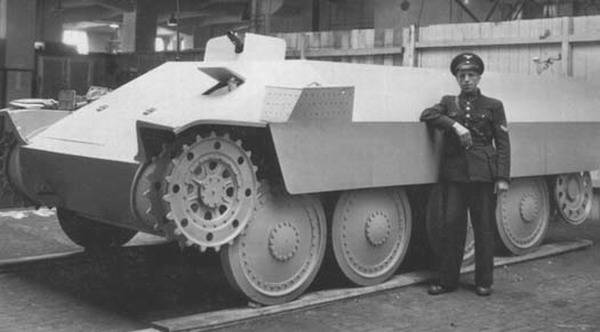
Layout from a different angle
Despite the use of relatively thick and heavy armor plates, the Gep.MTW BTR from BMM complied with the requirements for combat weight. This parameter was at the level required by the customer 5 m. The length of the car was approximately 4,2 m, width - 2,34 m, height - no more than 1,5 m. Depending on the type of engine used, a sufficiently high power density could be achieved, which made it possible to accelerate to the highway 60 -65 km / h. Cruising, according to some, could reach 600 km.
The development of the project Gep.MTW / Vollkettenaufklürer 38 (t) / Kätzchen was completed at the beginning of 1944. Soon, BMM built a demo layout intended for display to customer representatives. The military got acquainted with the new development and were satisfied. The development company, as well as the competitor company, received permission to build a full-fledged prototype, which later had to take part in the trials.
With the participation of representatives of the customer, the authors of the project managed to solve the engine problem. According to reports, it was decided to build two prototypes with different power plants. The first prototype of the Kitten machine was to receive a less powerful Tatra 103 engine, while the second was planned to be equipped with a Praga NR motor with a 280 HP power. This allowed us to test two variants of the power plant in practice and select the best option.
In the summer of 1944, BMM and Auto Union presented two prototypes of promising armored personnel carriers for testing. This technique almost at the same time went to the site to check that, among other things, made it possible to compare cars in full-time "competition". According to the results of the ground tests, the military drew conclusions about the prospects of both projects, and also formed a list of the necessary improvements.
Tests showed that the Kätzchen BTR from Auto Union surpasses the competitor in some respects. First of all, there was an advantage in handling and smoothness associated with hydraulic transmission and chassis design. At the same time, Vollkettenaufklürer 38 (t) had more powerful reservations and high mobility. In this case, the project of the company Auto Union needed rework due to the lack of reliability of the used transmission. The car from BMM did not need serious modifications.
After completion of the tests, both cars were returned to the manufacturers for refinement. In the future, a new stage of testing was to begin, which made it possible to determine the success of the modifications and select a machine for delivery to the troops. Nevertheless, new comparisons were not needed, since the choice was made far beyond the limits of the landfill. In September, 1944, the German command introduced new restrictions on the development of advanced armored vehicles related to the types of used chassis. The Kätzchen car from Auto Union, built on a new chassis, now could not be built serially. For this reason, the BMM project became the winner of the competition for the creation of an armored personnel carrier.
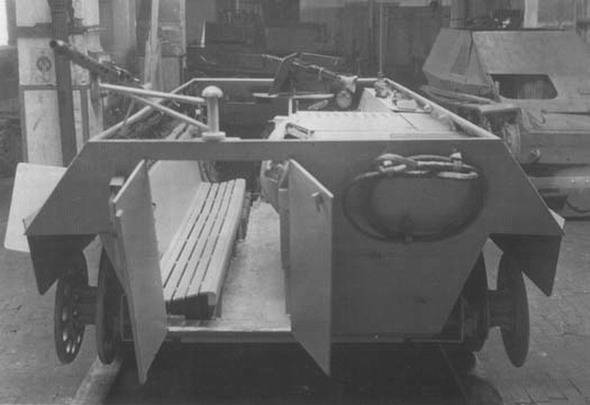
Stern armored personnel carrier with a door for the landing
According to some reports, in the autumn of 1944, the assembly of the second machine Vollkettenaufklürer 38 (t) started at the BMM plant, but it was not completed. At the final stage of the war in Europe, German enterprises were loaded with a mass of orders, because of which they could not start a full-fledged production of new equipment, and in some cases could not even complete the assembly of prototypes. As a result, until the end of the war, only one prototype of an armored personnel carrier was built. The second car with a more powerful engine was not completed and not tested.
The only prototype of the new armored personnel carrier, apparently, remained at the factory for some time, after which it fell into the active army. There is information about the use of this machine on one of the front sections. For various reasons, the operation of the armored personnel carrier did not last long: in the spring of 1945, it was destroyed.
The actual results of the Gepanzerter Mannschaftransportwagen or Kätzchen program were very modest. In less than a year, the firms engaged in the project developed and built only two new types of armored vehicles. This technique has been tested, but was never brought to the desired state, and also did not enter mass production. Two prototypes at the final stage of the war were thrown into battle, but could not become famous: one car was destroyed, and the second was seriously damaged and was thrown by the crew. Thus, two attempts to create a new armored personnel carrier to replace the existing equipment did not succeed, because of which the troops had to continue the operation of the old-type production armored vehicles.
Based on:
http://panzernet.net/
http://aviarmor.net/
http://shushpanzer-ru.livejournal.com/
Chamberlain P., Doyle H. Complete reference book of German tanks and self-propelled guns of the Second World War. - M .: AST: Astrel, 2008.
- Ryabov Kirill
- Aviarmor.net, Panzernet.net
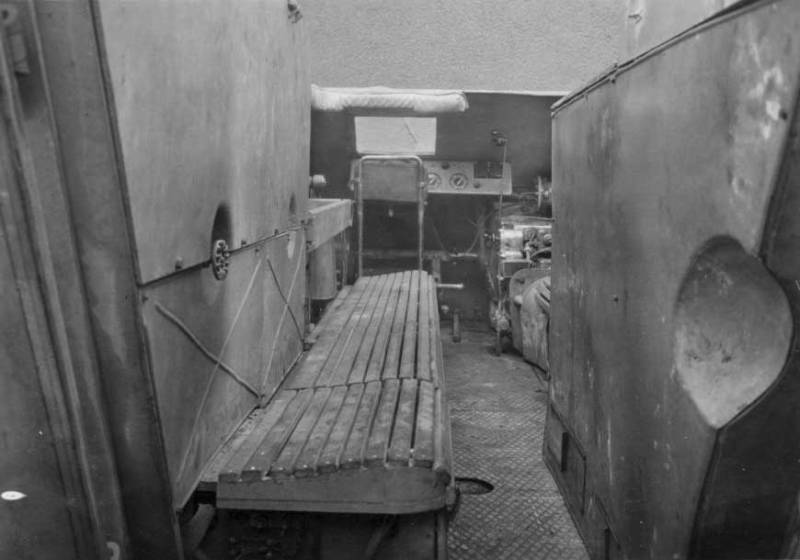
Information